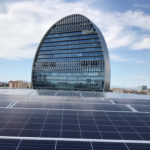BBVA banks on solar energy at its Madrid headquarters
The Spanish environmental company EDF Solar has installed 523 solar panels with a production capacity of 236.182 kWh/year at BBVA Group headquarters. As a result, the bank will reduce CO2 emissions in the atmosphere by 106 metric tonnes.

BBVA reaffirms its commitment with renewable energy by deploying a photovoltaic system consisting of 523 units — amounting to 175.21 kWp (peak power) and capacity to generate 236.182 kWh/year — at the Group’s Madrid headquarters. EDF Solar, a leader in industrial self-consumption facilities, was tasked with the delivery of the project, which was completed in November.
The solar panel installation will enable BBVA to reduce CO2 emissions by 106 metric tons, which is the equivalent to planting 8,030 trees. The new facility will boost solar energy production at the headquarters by up to 441 Mwh/year, the equivalent of the annual electric consumption of 126 Spanish households. By taking this additional step — reiterating its commitment to clean energy — BBVA contributes to the fight against climate change and its detrimental impact on the planet.
Harnessing alternative sources of electricity generation has been a societal challenge since the oil crisis in the 1970s. Today, solar power is a reality and has become the most promising long term potential resource for electricity supply. Clean energy production, reducing dependence on energy imports (fossil fuels), limiting greenhouse-causing emissions, and investing in renewables are key factors for reaching the goals established for the ecological transition.
To appreciate the advantages of solar power, it is worth noting that photovoltaic energy is the only renewable energy source that can generate electricity at the same location where it is consumed. Photovoltaic energy is now the leading recipient of energy investments: $160 billion dollars representing 57 percent of investment in renewables and 47 percent of all new generation. Factors that contribute to this growth include reduced costs, which have fallen 77 percent in the last seven years, and the accelerated maturation of the solar batteries and storage capacity, also with a drop in prices, falling 80 percent since 2010.